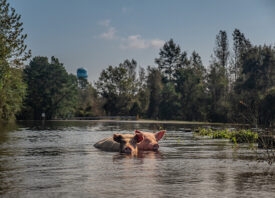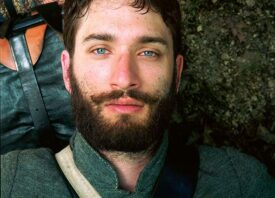Search this site
Photographing Natural Disasters: Ideas & Ethics


In 2020, swaths of our planet were ravaged by wildfires and hurricanes as global temperatures soured. The Australian bushfire crisis killed or displaced almost three billion animals, and California experienced the worst wildfire season on record. Severe floods in West and Central Africa hit 760,000 people, with more than a hundred killed. In India and Bangladesh, Cyclone Amphan killed more than a hundred people and displaced millions.
These unprecedented events served as a painful and tragic wake-up call for people around the world, and according to a poll from Morning Consult, nearly three in four U.S. adults said climate change played a role in a brutal disaster season. One in five said they’d consider moving due to the impact of natural disasters on their region. We’re living amid more than one global crisis.
As the connection between climate change and extreme weather events becomes increasingly clear, ethical and comprehensive coverage of these disasters has proved more urgent than ever. These are the images that will inspire action today and bear witness a hundred years from now. We asked four photojournalists about their work on the frontlines of fires, floods, and hurricanes. Read on for their tips and insights for documenting some of the most important stories of our time.
Follow ethical guidelines.
“I’m a member of the National Press Photographers Association and follow their code of ethics on all assignments–not just because I’m a member, but because it’s a good framework,” the South Carolina-based photojournalist Sean Rayford tells us.
The NPPA code of ethics, which you can read in full here, includes providing accurate and comprehensive coverage, never paying sources or accepting payment from sources, showing compassion, and respecting the dignity of all people. “Photojournalists should recognize that the folks they encounter during natural disasters may be going through one of the most traumatic experiences in their lifetimes, so ethics are essential,” Rayford says.
These images are also historical documents, so accuracy and integrity are paramount. “At this point, I feel that my biggest role as a photojournalist is lending to a first draft of history,” Rayford admits. “This concept is nothing new to a journalist, but it’s become more important to me the older I get. Some stories have more historical significance than others, and natural disasters fall into the category of higher significance.”

Seek proper training.
Justin Sullivan’s work focuses on conservation and wildfires in South Africa, with an emphasis on the wildland firefighters who work high in the mountains. He’s also a qualified wildland firefighter himself, so he has the training to think on his feet in the field. “There are so many photographers who try to run up a mountain in shorts and flip flops and take images of firefighters,” he laments. “It’s extremely dangerous without any training, protective gear, and experience.
“By doing this, people not only put their own lives at risk but also the lives of first responders who will need to rescue them when something goes wrong. I started in this manner, and although I quickly got the necessary training and protective gear, I took risks that I regret today and am lucky to be alive.” With five years of experience under his belt now, he knows to be aware of his surroundings, follow protocol, and wear the same protective gear as his fellow firefighters.
Even with training, he understands that safety is never guaranteed. “I’ve had many close encounters over the years,” Sullivan says. “I’ve had to run through fire to get to a safe zone; I’ve been circled by fire and had to wait it out on an open field. I’ve had to hunker down as flames burned over my head, and I’ve had to drive my car out of multiple deadly situations.”

Assist if and when you can.
“In each moment, I ask myself, ‘Is the picture I am about to capture going to outweigh the consequences of not assisting?’” Sullivan says. “I’ve been faced with many such situations, and I definitely lean more towards assisting during a disaster.” If you’re qualified and able to help others without risking your safety or anyone else’s, do it–even if it means missing your shot.
“The encounter that sticks with me today was when a wildfire on the coast just East of Cape Town came hurtling down the mountain during a cut-off low pressure weather event, with sustained winds of over 80kmph, destroying more than thirty homes and leading to most of the small coastal town being evacuated,” Sullivan remembers.
“I picked up a man running down the middle of the road, almost towards certain death as walls of fire were behind and in front of him, managing to get him out just in time.” Later, Sullivan circled back to pick up an elderly couple who was left stranded after their car caught fire. Looking back, it’s a choice he’d make again. “It was definitely a chaotic experience, but I’m just glad I was in the right place at the right time,” he tells us.


Start close to home.
You don’t always have to travel halfway around the world to find these stories. “My first serious coverage of flooding came when twenty inches of rain fell where I live in Columbia, SC,” Sean Rayford remembers. “There was a cascade of dams that broke, and it was pretty insane to see those results while running into people you know in your own town.
“The deluge started while I was covering the funeral of a police officer killed on duty. It rained that whole day and night. I covered flash flooding in my town and then followed that water 100 miles east as it surged toward the Atlantic, swamping riverside towns and communities along the way. It lasted longer than a week and was somewhat of a crash course for me.”
In many cases, Rayford has been the only photojournalist on the scene. Starting with local stories means you’ll have access outsiders might not, and you’ll be able to find your bearings on your own time and in a familiar environment.
Connect with local partners.
Ethan Lovell got his start providing disaster relief around the world with Waves For Water, a non-profit tackling the global water crisis, and although he now manages projects himself, he always connects with organizations on the ground or organizes a team with local people. His goal is to empower communities and amplify their voices–not get in the way.
“Number one tip: stay positive,” Lovell advises. “You are there to help, and people appreciate a foreigner traveling all the way to a compromised and unknown territory. In many places, it’s an ‘all hands on deck’ scenario, so it’s a good method to partner up and share resources with other organizations that share a similar approach. You must always respect the local culture and know your surroundings.”
For him, documenting disasters goes hand-in-hand with providing relief, and both represent a long-term commitment that doesn’t begin or end after he’s taken photos. “It is always our initiative to continue to support the projects and the local teams because many of the places we visit have pre-existing issues, with little or no access to safe drinking water before the disaster events occurred,” he says.
“I am not there just to document. I am there to take part in a greater responsibility, and I am extremely passionate about the work we do in the field. My job is to tell the human stories about the people whose lives have been affected. Telling these stories can be beneficial to raising awareness about the event that occurred but also to raising more funding to prolong and expand local efforts.”

Be unobtrusive.
“My credibility is worth more than my paycheck, so in addition to following all ‘standard’ journalism practices of truth and honesty, I also follow my own rule of respect and non-intrusiveness,” the photojournalist Mark Wallheiser tells us. “Victims of natural disasters have often just lost everything they have worked their lives for and more times than not, in the case of hurricanes, look the worst they’ve ever looked. Be kind, and don’t force yourself on them.”

Stay safe.
When covering disasters, safety is the priority. “Don’t be a fool, and don’t be a dead hero,” Wallheiser urges. When photographing hurricanes, he always wears stainless steel insoles for his boots and watches where he steps. “There are nails and glass everywhere. Infected puncture wounds in your feet is a show-stopper with no medical attention nearby,” he explains.
“Also, take your own food, water, and gasoline. Gasoline is worth more than cash. Beware of wading through flooded neighborhoods. Besides the various chemicals and germs in the water, snakes, and massive floating balls of fire ants, it’s hard to tell where the backyard swimming pools are, and once you step off in one of those, you’re sunk.
“Finally, take two of everything. Two laptops, two extra cameras, two ways to get the images out, two flashlights (or more), etc. On some items, you need a back-up for your back-up. Your number one job is to get the images out. If you can’t get a signal or are injured or dead or your laptop dies, it doesn’t matter how good your images are.”
Keep a small footprint.
Staying out of harm’s way is about more than just your safety but also the safety of others. “You must be fully responsible for staying healthy and not taking up resources for relief crews such as SAR and medevac,” Ethan Lovell advises. “Most likely, the people affected are still in shock and had their worlds turned inside out. Some may have lost loved ones or may need medical attention.
“Shoot respectfully and always watch what you are standing on or under at all times. I would also recommend you pack light and effectively. I take great pride in having absolutely everything I need for working in the field and setting up an effective base of operations. It is important to have a secure, dry, and mosquito-free place to stay. Find a place that locks up well in a safe part of town. Also, try to keep a low profile, if possible. I usually try not to overstay my welcome in certain places and draw any unwanted attention, especially when I’ve got all of my gear on me.”

Pace yourself.
“I try to make it a point to stay hydrated and fed and to get good rest,” Rayford says. “This means you have to bring your own food and water. Waffle House isn’t going to be open. Being physically fit helps when you have to wade around in thigh-deep water for several hours. Tired or hungry, we are more likely to make mistakes. In these scenarios, I’m making photos from sunup to sundown, while sending photos throughout the day and the bulk of photos at the day’s end. You’ve got to pace yourself, and there is no time for distractions.
“I also prepare a lot. I’ll spend days packing for a hurricane or flooding event. Each of my experiences has given me insight on items that can help me do a better job, and I’m constantly developing a better tool kit. Packing all that stuff, and knowing where it is, is a task in and of itself. I’ve only been seriously covering these events for five years, and each new hurricane season I come armed with more knowledge and equipment.”

Try to find the good.
Sean Rayford has seen his fair share of pain and loss, but he’s also tried to find moments of kindness. “The most rewarding part of covering flooding is the opportunity to see humanity at its finest,” he tells us. “There is definitely suffering, but there are also folks helping one another and working together to survive the madness of natural disasters.
“It’s a reminder of the good in people and our ability to overcome challenges. People have given me food and invited me into their homes, thankful that someone was there to document a challenging moment in their lives. It’s inspiring; it’s grounding, and it makes me a more compassionate person.”

Spread the word.
Mark Wallheiser has covered 45 hurricanes and tropical storms, and he was part of the team that contributed to the 2006 Pulitzer Prize-winning coverage of Hurricane Katrina for the Biloxi Sun Herald. Over the years, he’s learned that sharing these images can bring lasting change and relief to those who need it.
“The world’s perception of natural disasters–in my case, hurricanes–is dependent on the visuals coming out of disaster zones in real-time,” the photojournalist tells us. “The power of the still image is never more evident than it is in natural disasters. Strong images often lead people to take action in assisting, volunteering, or donating to relief efforts.” Where and how you publish your photos is up to you, but get your photos seen, and make it easy for people to contribute to the communities and individuals whose stories you’ve documented.


